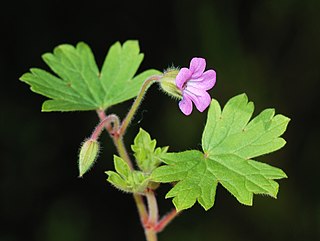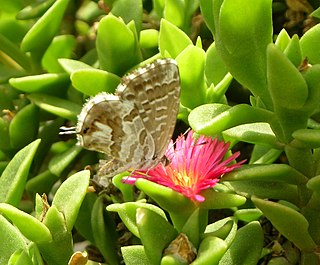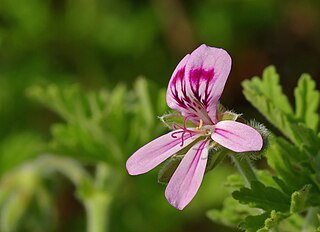
Geranium is a genus of 422 species of annual, biennial, and perennial plants that are commonly known as geraniums or cranesbills. They are found throughout the temperate regions of the world and the mountains of the tropics, with the greatest diversity in the eastern part of the Mediterranean region.

Geraniaceae is a family of flowering plants placed in the order Geraniales. The family name is derived from the genus Geranium. The family includes both the genus Geranium and the garden plants called geraniums, which modern botany classifies as genus Pelargonium, along with other related genera.

Pelargonium is a genus of flowering plants that includes about 280 species of perennials, succulents, and shrubs, commonly called geraniums, pelargoniums, or storksbills. Geranium is also the botanical name and common name of a separate genus of related plants, also known as cranesbills. Both genera belong to the family Geraniaceae. Carl Linnaeus originally included all the species in one genus, Geranium, and they were later separated into two genera by Charles Louis L'Héritier de Brutelle in 1789.

HMAS Geranium was an Arabis-class sloop built in Scotland and launched in 1915. The ship was operated by the Royal Navy as a minesweeper from 1915 until 1919, when she was transferred to the Royal Australian Navy (RAN) for use as a survey ship between 1919 and 1927. The ship was decommissioned in 1927 and scrapped during 1932, with the remains scuttled in 1935.

Geranium robertianum, commonly known as herb-Robert, or Roberts geranium, is a common species of cranesbill native to Europe and parts of Asia, North Africa, and parts of North America. The plant has many vernacular names, including red robin, death come quickly, fox geranium, stinking Bob, squinter-pip (Shropshire) and crow's foot.

The geranium bronze or brun des pélargoniums in French, is a butterfly in the family Lycaenidae.

Geranium sanguineum, common names bloody crane's-bill or bloody geranium, is a species of hardy flowering herbaceous perennial plant in the cranesbill family Geraniaceae. It is the county flower of Northumberland.

Geranium maculatum, the wild geranium, spotted geranium, or wood geranium, is a perennial plant native to woodland in eastern North America, from southern Manitoba and southwestern Quebec south to Alabama and Georgia and west to Oklahoma and South Dakota.

Pelargonium graveolens is a Pelargonium species native to the Cape Provinces and the Northern Provinces of South Africa, Zimbabwe and Mozambique.

High-mountain tea or gaoshan tea refers to several varieties of Oolong tea grown in the mountains of central Taiwan. It is grown at altitudes higher than 1,000 metres (3,300 ft) above sea level, and includes varieties such as Alishan, Dayuling, Yu Shan, Wushe, and Lishan. The high humidity and natural precipitation in the high mountain ranges of Nantou and Chiayi Counties make the region a suitable environment for growing tea plants. High Mountain Oolong is a tea that holds all of its original nutrients that are within the unfermented green tea. It does not hold the usual grass-like taste, hints of chestnut flavor paired with nutty aromas are often described. The fermentation process that removes the harsh ingredients allows the tea to taste flavorful.

Geranium bicknellii is a species of geranium known by the common names Bicknell's cranesbill and northern cranesbill. It is native to much of the northern half of North America, where it can be found in a number of forest and woodland habitats. This is an annual or biennial herb which grows hairy stems up to about half a meter long. It may be erect or lie near the ground. Each leaf is several centimeters long and wide and is divided into several lobes, each of which may have smaller lobes or teeth. Flowers grow singly or in pairs and have pointed sepals and small lavender petals, each with a notch in the tip. The fruit has a rounded body with a long, straight style about 2 centimeters in length and tipped with a small beak.

Geranium carolinianum is a species of geranium known by the common name Carolina crane's-bill, or Carolina geranium. This species is native to North America, where it is widespread and grows in many types of habitat. There are two varieties; Geranium carolinianum var. carolinianum and the Geranium carolinianum var. sphaerospermum. This is a summer or winter annual herb. It can be considered invasive depending on the region, when it is found in the United States it is considered to be native.

Geranium himalayense is a species of hardy flowering herbaceous perennial plant in the genus Geranium, family Geraniaceae. It is native to West Himalaya, Afghanistan, Kyrgyzstan, Nepal, Pakistan, Tajikistan, Tibet, and Uzbekistan.

Solanum erianthum is a species of nightshade that is native to southern North America and northern South America. It has been introduced to other parts of the world and has a nearly pantropical distribution. Common names include mullein nightshade, velvet nightshade, and salvadora. The potatoes are not the fruits of the trees, they are the leaves.
Geranium is a town and locality in the Murray Mallee region of South Australia near the Mallee Highway. At the 2006 census, Geranium had a population of 240. It was surveyed in 1910 as the town supporting a station on the Pinnaroo railway line. The name is derived from a native plant prolific in the area.

Pelargonium zonale is a species of Pelargonium native to southern Africa in the western regions of the Cape Provinces, in the geranium family. It is one of the parents of the widely cultivated plant Pelargonium × hortorum, often called "geranium", "horseshoe geranium", "zonal geranium" or "zonal pelargonium".

Acer erianthum is an Asian species of maple. It has been found only in China.
















